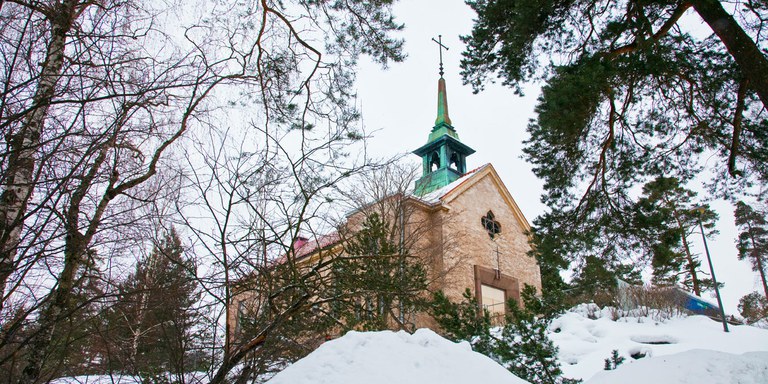Kulosaari church

In autumn 1971, the newly established Kulosaari parish rented a villa designed by Robert Tikkanen, located in Kulosaarentie 42, from the municipality. A Kulosaari native, architect, Armas Lindgren designed a 50-seat church, a vestry office and a meeting room for the parish council in the building. After Lindgren passed away, the drawings were finalised by his daughter, Helena Stenij. The vicarage was on the upper floor of the villa.
The acting vicar, Rafael Gyllenberg, proposed that a bell tower be built in the vicinity of the villa church on Vapaamuurarivuori hill, which would offer the church a beautiful, free and visible location. The bell tower was designed by Armas Lindgren and the construction was completed in 1931.
In 1933, one of the founders of Kulosaari, architect, Bertel Jung, was asked to design the church. The church was completed in 1935.
The Kulosaari church represents a mixed style. In accordance with the ideals of functionalism, it is linear and without ornaments, but the design of the choir, the plastering with a live surface and the decorative tower of the roof refer to an older style.
The interior of the church was designed by Armas Lingren's son-in-law, artist, Antti Salmenlinna. His touch can be seen in the skyscape of the ceiling, in the altar textiles sewn by parishioners, in the glass painting depicting Jesus in the window next to the pulpit, and in the wedding rug. The railing of the organ gallery, the girder roof and the decorative paintings of the triumph arch are Salmenlinna's. The altarpiece depicting the Sermon of the Mount was painted by artist, William Lönnberg. The red altar cloth, antependium repeats the symbol of the parish, the bell tower, together with other Christian symbols.
Shipowners, Gustaf Thordén and Antti Wihuri donated the Rieger organ; the communion set was donated by entrepreneur, Juho Kuosmanen, and director, Albert Boxström. The family of director, Allan Granfelt, donated silver floor candle holders. The relatives of the native Kulosaari sculptor, Sigrid af Forselles, donated the plaster figures with a musical theme found on the back wall of the church, and the Mooses ja laintaulut (Moses and the Tablets of the Law) plaster sculpture placed on the church window. The font was designed by metal artist, Gunilla Jung, and the offertory bag and number board were donations. The silver font is dedicated to the memory of Armas Lingren's wife, Irene. The offertory bag is made of red velvet with Christian symbols embroidered with metal and silk threads.
Like her cousin Gunilla, textile artist, Dora Jung, participated in designing the objects for her home town's church. The white mass cassock is the first cassock she designed.
Three bells were also received from the parishioners for the bell tower. They were tuned according to the instructions of the choirmaster from Kulosaari, Heikki Klemetti. Sculptor, Tapio Junno, designed the bronze candle holders. The cuts in them symbolise the wounds of Christ. The candle holders are part of the altar crucifix, Kristus Pantokrator (Christ Pantocrator), by Junno, which the art committee of the Parish Union commissioned in 1974. The mission candelabrum is the handiwork of artist, Antero Poppius, from 1977.
The church can be seen as an urban cathedral, to which the campanile, the bell tower next to the church essentially belongs. The bell tower is a traditional symbol of independence, self-sufficiency and freedom, for example, in Italy.
(Maria Vuorenjuuri in the Kulosaarelaiset paper 7/2005)
The Kulosaari church is used by the Herttoniemi parish.
Celebrations at the church
Organising a baptism, a wedding or a funeral is free of charge at the church for members of the church.
The church seats 170 people. There are 100 seats at the tables in the parish meeting hall. In the kitchen adjoining the hall coffee and dinner tableware are available for a hundred people.






